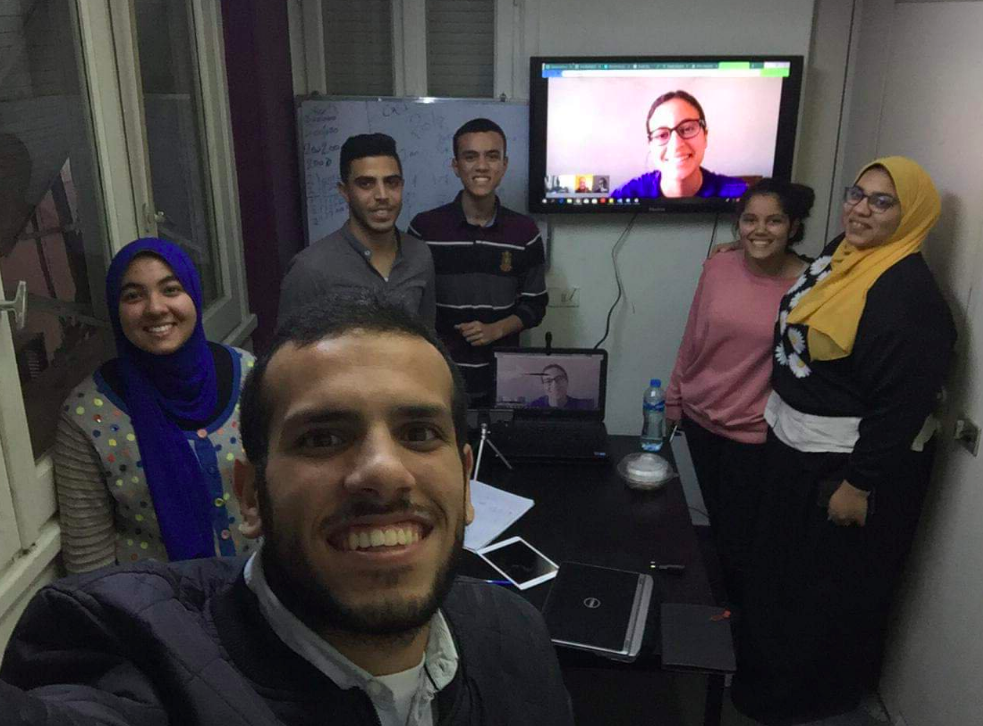Collaborations
Cairo iGEM:
CUiGEM, the University of Cairo's new iGEM team, reached out to us early in the iGEM season asking for advice on starting team. We met on Janurary 26, 2019 to discuss our iGEM experience and offer them some guidance. We told them about what we found works in terms of team structure, finding funding/sponsors, selecting a project and track, etc.
Once they selected their project, we also helped give them some advice on how to isolate the Debaryomyces hansenii strain of yeast they needed for their project. It's been great seeing this new team's progress throughout the season!

UofCalgary iGEM:
University of Calgary's iGEM team reached out to us for collaborating on a project to visualize iGEM team metadata. Specifically, the aim of the project was to map collaborations between iGEM teams and topics they worked on. Calgary worked on scraping the iGEM wikis using Beautiful Soup in Python, which we built off for our interactive visualization at Map of Collaborations.
The UCalgary team also developed an education package which they were kind enough to share with us. We gained insight into their methods in educating new members on skills related to iGEM and we were able to provide feeback and share how our methods compared.

UAlberta iGEM:
Near the beginning of the year, we were approached by the UAlberta iGEM team who were looking to do some more in-depth mathematical modelling. They were wondering how best to answer some of their questions about their Beetector system with modelling such as: how many bees would they have to assay in the hive to give reliable results? How could they ensure that the signal would be visible? To help get them started and give some tips and tricks on how to effectively use modelling in iGEM projects, we met up online to share resources, have rudimentary workshops on modelling basics, and answer questions. This helped them complete and get started on their modeling. As well as, it allowed them to start exploring this aspect of iGEM projects without having members with previous experience with mathematical modelling.
Additionally, in the fall with one of our team members (Alina) during their co-op placement at the University of Alberta helped the UAlberta team. Alina was able to help out in the lab with troubleshooting some experiments surrounding the construction of their construct and be an extra hand on deck before the wiki freeze!

Newcastle iGEM:
We first met Newcastle iGEM at the 2018 Jamboree and were very interested in their project ‘Alternative Roots’, which sought to engineer endophytic bacteria for agricultural applications. Since Waterloo’s 2019 project has much in common with this work, a collaboration seemed only natural. During a visit to the UK in April, Dylan met with returning team member Connor and team advisors Dr Thomas Howard and Dr Jon Marles-Wright. This discussion informed our experimental design, choice of controls, and general project strategy.
In the following months, we arranged several video calls between our two teams. We continued to discuss experimental aspects of the Waterloo project, especially the use of minimum inhibitory concentration (MIC) assays to determine the toxin tolerance of engineered and non-engineered strains. Newcastle performed similar experiments in both 2018 and 2019 and provided helpful literature references and practical advice for this work.
Once Newcastle had chosen their 2019 project, we assisted with aspects of their mathematical model, which sought to describe a CRIPSR SHERLOCk system. We provided relevant resources regarding enzyme kinetics and differential equation modelling and discussed possible limitations of the model.
(Pictured: Dr Thomas Howard, Dr Jon Marles-Wright, Connor, Dylan)

(Pictured: Matt, Connor, Danielis, Karen)

qGEM
Dylan met with qGEM members Ruben and Janice in June during a visit to Kingston. We discussed design and experimental aspects of our respective projects, as well as modelling, human practices, and possible funding sources. Although qGEM’s project, a handheld THC immunoassay, was very different from our own, it was beneficial to discuss common challenges and approaches.
(Pictured: Ruben, Janice, Dylan)

NYU iGEM
Spoke with NYU iGEM about their optogenetic gene circuit and provided advice on construction and testing
OSU iGEM
Over the summer, we worked with OSU iGEM to discuss and share information on the use of biostimulants and engineered microbes for nitrogen fixation in crops. Topics of focus included the social and regulatory barriers preventing the implementation of engineered systems in Canada and the United States.
UBC iGEM
Dylan met with UBC iGEM members Tylo, Samuel, and Emilia in August during a visit to Vancouver. We discussed experimental and design aspects of our respective projects, as well as mathematical modelling, strategies for integrated human practices, and differences in team administration and structure between our iGEM teams.
(Pictured: Tylo, Dylan, Samuel, Emilia)

oGEM (Ontario iGEM conference)
Finally we would like to thank the University of Guelph iGEM team for hosting the oGEM conference on the 5th of October this year. We were glad to be given the opportunity to present our project progress and recieve feedback on our presentation.

